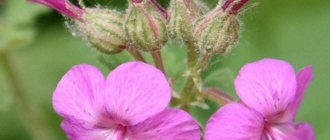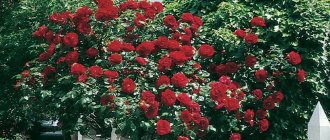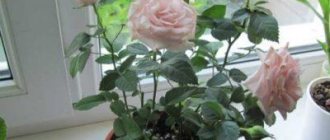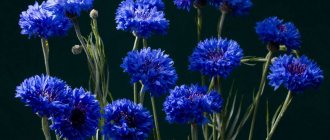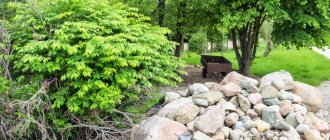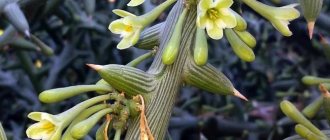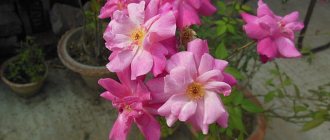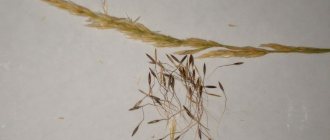In the deserts of the Middle East there is a mysterious flower. Under the scorching sun, in the grip of hot sand, its leaves inevitably die, clutching the heart of the plant with its branches, like senile fingers. And, having turned into stone, the dried up ball begins its endless run in search of living water. With the first drops of saving moisture, a miracle happens: the palm of the flower opens and tiny white flowers of amazing beauty sprout inside. But the time comes, the magic leaves again hide the immortal shoots and the journey continues... A fairy-tale legend about a resurrected flower? Not really. Such a plant really exists. His name is the Rose of Jericho.
Legends about the flower
The biblical version of the appearance of this flower claims that Mary discovered the unusual plant on her way to Egypt. She blessed him with immortality. Therefore, it is sometimes called the “hand of Mary.”
The second legend is described in the famous story “The Rose of Jericho” by Ivan Bunin. It says that the name of the herbaceous plant was given by the Monk Savva, who settled in the Judean desert.
Rose of Jericho - what kind of flower
Rose of Jericho is a perennial, herbaceous plant that loves shade and naturally lives in the desert. It has existed for almost 300 million years. In the dry stage, the flower can last for several decades, so it is often passed down from generation to generation, especially in Eastern countries, particularly in Egypt.
Rose of Jericho
Sometimes they put some small gift in the flower, usually jewelry, and wait for it to close. After the gift recipient places the rose in the water, it will open and the gift will reveal itself. This is a very beautiful and original way, for example, to make an offer.
Description of the rose of Jericho plant:
- life form - herbaceous perennial;
- maximum height 15 cm;
- the leaves are very small, grayish-green in color;
- small white flowers;
- reproduces by seeds.
For reference! The Egyptian rose belongs to the Brassica family and is the only representative of the Anastatica genus.
Egyptian rose in natural conditions
The scientific name of the rose of Jericho is Anastatica hierochuntica. It comes from the ancient Greek words “revived” or “resurrected.” The plant was first discovered in the Middle Ages by knights - crusaders, who noticed the amazing ability to revive the flower. Returning from the hike, they illuminated the unusual treasure they found and gave it the name “Flower of the Resurrection.”
According to the biblical version, Mary discovered the plant on her way to Egypt, giving him the blessing of immortality. That is why it is also called “Hand of Mary”.
Another legend, which Ivan Bunin describes in his story “The Rose of Jericho,” says that the herbaceous plant received its name from the Monk Savva, when he settled in the Judean desert.
The Rose of Jericho grows where most other botanical species are unable to survive.
Distribution area:
- Western Asia (Saudi Arabia, Qatar, Syria, Israel, Jordan, Iran).
- North Africa (Morocco, Algeria, Egypt).
Despite its name, the flowers of the plant bear little resemblance to a classic rose.
During the flowering period, the gray leaves are decorated with miniature white flower petals, which later turn into pods with seeds.
Due to its small size (about 15 centimeters) and tight adherence to the soil, the rose is practically inaccessible to animals.
Description of the plant
Rose of Jericho (spike moss) is a species of herbaceous annuals of the Brassica family, a member of the genus Anastatica (“the only one”).
This is a small plant, no more than fifteen centimeters long. Small leaves of a grayish tint. The flowers of the plant are very small and white. The Rose of Jericho, the photo of which you see in our article, grows in the desert in early spring, and flowering and fruit set begin very quickly. At this time, there is still enough moisture in the desert for the plant. Like other herbaceous annuals that grow in drought conditions, the rose of Jericho is an ephemeral plant.
With the onset of drought, the tiny stems dry out and begin to curl inward. A kind of ball is formed. Strong gusts of wind easily tear off the top part of the plant, and it rolls along the sand. Along the way, it collects the same tangles and forms very large tumbleweeds. They move around until they get stuck in some wetter place. Due to humidity, the stems swell and begin to straighten, and the seeds spill out of them.
It should be noted that the seeds of this amazing plant remain viable for several years, but when placed in a sufficiently humid environment, they germinate in just a few hours.
You need to know that there is another representative of the flora with similar properties - squamosal selaginella. The Rose of Jericho is a completely different, unrelated plant, although the Hawaiian club moss is very similar in its life cycle and appearance to the anastatic plant.
Plant life cycle
It is noteworthy that the rose of Jericho is often called another plant - Selaginella lepidoplate. Although the Hawaiian club moss resembles anastatica in its appearance and life cycle characteristics, it would still be a mistake to consider it a Jericho rose.
What actually happens to a plant during a period of drought? By the end of the growing season, the rose leaves fall off, and the branches die and dry out, shrinking into a dense ball, inside which the fruits are securely preserved. The dried root breaks off, turning the rose of Jericho into a “tumbleweed.” This is how the plant conquers more and more new habitats, waiting for periods of rain.
On favorable moist soil, dried branches open, releasing pods into the light that will give life to new shoots.
And, although according to legend the rose is reborn endlessly, its life cycle in reality is still limited and is about thirty years, which is also impressive!
But what is especially surprising is the fact that when dried, this plant can be stored for many years.
Kinds
There are several types of Rose of Jericho, so it is important to know their differences before deciding what kind of care a particular plant needs.
The most common type is Martens rose. It has erect stems that can reach a length of thirty centimeters, but gradually they become lodging. Its branches are slightly reminiscent of ferns, but the tips of the leaves are silvery-white in color.
Selaginella squamofolia has stems that do not grow more than ten centimeters in length. If the humidity in the room is insufficient, they curl into a ball, but as soon as the plant is watered, it immediately comes to life and scatters its leaves.
Rose symbolism
Silaginella squamosal is a symbol of longevity and resurrection.
- This is a long-lived flower, so it can be inherited as a symbol of the family.
- It is customary to give it on the day of the Resurrection of the Lord, as a reminder that after death the resurrection of the soul will come.
- The dried ball is given to each other by lovers, placed inside the ring. When the flower opens, the rings are taken out.
- When placing a rose inside a cabinet, it will repel moths.
- The bush thins out the light aroma of meadow herbs, so it is used as a natural air freshener.
- Disinfects the air from harmful microorganisms and absorbs tobacco smoke.
- The mechanism of opening and closing branches may be interesting for children.
Additional Information! In the story “The Rose of Jericho,” I. Bunin talks about a legend that says that the name of the flower was given by the Monk Savva when he was in the Judean desert.
The bush does not come to life in the literal sense of the word; dried shoots do not become green again, as flower catalogs sometimes promise. When placed in a humid environment, they open, and the seeds remaining inside begin to turn green. But even the process of opening and closing branches is interesting to observe.
Growing
Rose of Jericho needs high humidity (at least 60%), so it does not feel very comfortable in indoor conditions. If you want to place this plant not in a florarium, but in an ordinary container, then you should know that with high humidity, good ventilation must be ensured. Place the pot in a tray with peat, sphagnum or expanded clay, which need to be moistened regularly.
It should be noted that the rose of Jericho is a shade-tolerant plant, so you can create a mini-garden placed in a bottle. It will feel fine even on the north side, and if your windows face south, then the plant should be placed away from the window or slightly shaded with gauze or tracing paper.
Another important argument in favor of placing a plant in a bottle is the need to constantly maintain a certain humidity of the substrate (over-drying it is unacceptable). And in an open container, constantly wet soil will be harmful to the plant and can even kill it.
The composition in the vessel (as in the container) should be watered with settled and soft water. Its temperature should be room temperature. The soil for growing roses should be slightly acidic; do not forget to place good drainage at the bottom of the bottle or aquarium.
For better growth, your green pet should be fed from time to time. This is usually done in spring and summer. Use diluted nutritious fertilizer (in a ratio of 1:3). Using a long wire, you should loosen the ground so that air penetrates better into the soil.
How to care for roses at home
Landing
Selaginella should be planted in the form of a dry brown ball. In this state it can be transported, especially during periods of drought. To plant, you need to put the ball in water and within a day the plant will fully open.
Illumination and temperature conditions
The most optimal temperature for the plant is 20 °C. In this case, the flower should be placed in a slightly shaded place. When exposed to direct sunlight, the rose gets burned and becomes pale in appearance.
Selaginella squamosal at home
Watering rules and humidity
Since the plant grows in the wild in the tropics, it should be created in an environment close to natural. To do this, it is recommended to spray it with water 2-3 times a day.
Important! It is strictly forbidden to use cold water for spraying.
The plant requires abundant and regular watering. As soon as winter sets in, watering stops.
If a rose grows in a substrate, constant watering is required. The soil should be kept moist all the time and not dry out. In this case, it is better to carry out the procedure through the pallet. It is also necessary to regularly moisten the flower from above using a spray bottle.
Trimming
The rose of Jericho needs to be pruned when the plant ages and loses its beauty. In this case, you need to remove more than half of the shoots. As a result, shoots will begin to grow from dormant buds. You can also allow the plant to be pruned to give it a round shape.
Top dressing
Experienced flower growers advise feeding the flower every month. Nitrogen fertilizers are suitable for this.
Flower container size
This amazing flower can be grown in any container, as well as in containers. Often, novice gardeners wonder when growing a Jericho rose, how to care for it at home. As practice shows, the process does not cause any difficulties, since the flower is completely unpretentious.
How does the rose of Jericho reproduce?
The plant has nothing in common with garden roses, so it is impossible to propagate it at home. The uniqueness of the flower lies in the fact that upon contact with water it opens and seed pods form on it.
Revival of the Rose of Jericho
Growing problems, diseases and pests
Most often, the Egyptian rose becomes infected with fungal diseases. To avoid this kind of problem, you should periodically treat the plant with fungicides. To prevent the flower from rotting, the condition of its inflorescences must be monitored especially carefully. The formation of mold is strictly prohibited.
If you take good and proper care of a flower brought from Egypt, it will practically not hurt.
There are situations when spider mites appear on a dry rose. You can cope with the problem using a solution of laundry soap. These pests appear as a result of being in a room with dry air.
Important! After the life cycle, the plant requires a period of rest, which must be carefully ensured. You can prepare a flower for the dormant period in the fall by stopping watering it and reducing the humidity. As a result, the rose will take the shape of a ball, which can be stored in a dark place until spring.
Asteriscus dwarf
The exquisite and amazing rose of Jericho is rightfully considered an amazing plant that can exist for a century without water and then be reborn in just one day when moisture is supplied. Despite its name, the flower has absolutely no external resemblance to the usual rose. In nature, the plant travels across endless sands, attracting the attention of plant growers for many centuries.
At the same time, it still remains a mystery how a plant can be lifeless, and then, when interacting with water, so quickly revive and bloom.
Rose of Jericho: care
This is a rather whimsical plant, so certain recommendations must be followed.
Temperature
The optimal temperature can be considered +18 degrees. The flower loves warmth, but the indicated indicators should not be exceeded, that is, the room should not be warmer than +20 °C.
Lighting
Rose of Jericho does not tolerate exposure to direct sunlight; light partial shade is much preferable.
Varieties of the Jericho rose and the legends surrounding it
The most famous and widespread varieties of rose of Jericho are: Anastastica Jerichontica and Asteriscus dwarf. Both species and the rose known to gardeners and florists are united only by the name. They come from completely different species and genera. Look at the photos below for examples of similar varieties:
The legends and folk tales surrounding it are interesting. There are many stories surrounding the plant about its wonderful properties. Most of them, unfortunately, are rumors and lies. The plant does not treat any disease and is not a miracle cure. The water from under the plant also does not have any medicinal properties. Stories about the rejuvenating properties of water are one big fairy tale. The only special feature is the fact that the plant purifies the air from pollution and cigarette smoke. This feature is found in many potted flowers.
Rose of Jericho is a very interesting plant. It gives special pleasure to children who can observe its development. This plant is an excellent and original gift that recipients can use for months or even years.
Finally, enjoy a time-lapse video of the blooming process of this amazing plant.
[IFRAME]
Feeding and replanting
The soil should be fed monthly. You can use nitrogenous fertilizers. Once every two years (in spring), the rose of Jericho requires replanting to improve growth.
It must be said that the plant is resistant to various diseases and pests. Its only enemy is dry air, which can provoke the development of spider mites. A regular soap solution will help get rid of it.
The plant is propagated by green cuttings. To do this, in early spring, plant them in a small greenhouse and place it in the shade. The cuttings will take root in two weeks.
Feature of the plant
The life cycle of this rose goes very quickly. It starts growing in the spring, quickly begins to bloom and set fruit. Her flowers are white, small, inconspicuous. Seeds are produced in pods.
The peculiarity of this plant is that when there is a lack of moisture, it gradually curls towards the center and dries up, hiding the fruits in the middle of the ball. Having turned into a tumbleweed, it begins to look for new habitats, taking with it the same balls along the way.
Rose of Jericho
They move like this until the rain stops them. After watering, the rose comes to life, straightens, and seeds spill out of it, which quickly germinate in a humid environment.
Also, during its movement across the territory, these grains fall out and germinate under favorable conditions along the entire route. Soon the seedlings produce white buds, which again set seeds that can remain viable for a long time.
It is often confused with Silaginella lepidoptera, which does not bloom and reproduces by spores. It is she who awakens in humid conditions and goes to rest during drought. Those who have never seen what these balls look like when opened may confuse them. They can be distinguished by their root system:
- Anastatic has a tap root;
- in Silaginella it is fibrous.
Beneficial features
Rose of Jericho humidifies the air in the room and serves as a natural freshener, as it emits the aroma of steppe herbs. The plant has bactericidal properties and disinfects the air. In addition, it absorbs tobacco smoke. If a flower is placed in the bedroom, it will promote better sleep. In dried form, the annual can be used to combat moths in the closet.
Rose of Jericho is a very interesting and spectacular plant. With proper care, it will delight you with its exotic beauty.
How to plant a plant at home
Typically, rose of Jericho is sold in specialized stores in dried form.
Rose Lydia Lovely - what kind of flower is this from the floribunda family?
To grow the rose of Jericho indoors, you must follow these steps:
- Prepare a shallow pan and pour warm, settled water into it.
- Take the dried ball and place it, roots down, on a tray.
- As soon as the flower opens and green shoots begin to appear from the core, you need to plant it in a pot filled with soil.
Note! The soil for planting should be prepared in advance. To do this, the soil is mixed with sand and pebbles. Children can be seated in different pots.
Difficulties encountered during cultivation
If you improperly care for the Jericho rose, some problems may arise that will negatively affect the appearance of the plant:
- If the air in the room is very dry and untimely watering is carried out, then the ends of the stems of this plant will wrinkle, dry out and die.
- If the rose of Jericho is in a fairly dark place or lacks nutrients, then its pale leaves and elongated stems will tell about this. Also, under such conditions, the rose of Jericho grows very poorly.
- When this plant is exposed to direct sunlight and the soil dries out, the tips of this plant will dry out and turn brown. When leaves and stem tips die and become brown, it is imperative to reduce the air temperature in the room.
- If the plant withers and becomes very soft to the touch, this indicates high soil density and abundant watering. Under such conditions, the roots of the rose of Jericho can rot, as a result of which they die. In general, this plant is quite resistant to a variety of diseases and pests.
- If the air in the room is very dry, then this plant may be affected by a pest such as spider mites. To combat this pest, the plant must be sprayed with insecticides. You can also use a soap solution for this purpose.
More information can be found in the video.
“Rose of Jericho” is the name of plants with special properties. In Russia, there are several species of similar plants (there are several more) that combine a specific mechanism for regulating moisture, being in a dried-out “dormant” state associated with the period of unfavorable weather conditions (in the absence of sufficient moisture) and “awakening” when moisture appears . It is difficult to say why Selaginella was dubbed a rose; the plant has absolutely nothing to do with a flowering shrub.
One of the species, known as Selaginella lepidophylla, is native to America (Mexico, Peru), Jericho is located in Palestine, so calling the plant “Jericho” is greatly exaggerated. The true Rose of Jericho (Anastatica hierochuntica) is more deserving of its name, since its area of origin includes only the Palestinian territories. Not only is the name controversial, the plants differ in their botanical family and characteristic life cycle.
Selaginella squamofolia
Many distributors of flower products pass off this plant as the Rose of Jericho. They are very similar, but they are completely different plants. If you were sold Selaginella as the Rose of Jericho, then you should talk a little about this plant. Let's start with the fact that to grow a flower you need loose soil. A mixture of leaf soil, peat and sand in equal quantities is suitable, which should be constantly loosened. It will be good if you add orchid fertilizer to this mixture.
Pour the prepared soil mixture into a wide but low container with holes for drainage. It will be great if you take clay pots. Before filling it with soil, we lay out a drainage layer of pebbles on the bottom. Planting a flower can be done either by spores or by dividing the bush, but the second method is better and easier. Let’s immediately make a reservation that Selaginella’s root system is very delicate, so we do the planting very carefully.
Planting usually begins in the spring. From the overgrown bush we separate sprouts about 5 cm long, preferably with shoots. We plant 5 sprouts per pot. Water the soil in the pots well and cover the pots with film with holes for ventilation for a week. Selaginella does not like direct sunlight, so pots with seedlings should be placed on the semi-shady side, but not in the shade. You should also carefully monitor the temperature so that the temperature does not drop below +12 degrees.
You need to very carefully monitor the behavior of the leaves; from them you can determine the problem that has arisen with the flower:
- The leaves are limp and soft
. This means that you have over-watered and the roots are not getting enough air. You should temporarily stop watering and loosen the soil in the pot well; - The leaves are pale and too elongated
. It follows from this that the plant does not have enough lighting and too hard water is used when watering; - Leaves die off
. Very high ambient temperature and insufficient air humidity; - Rolling leaves
. The flower is affected by strong drafts and may require feeding.
As you can see, Selaginella is also a capricious plant, but with quality care it becomes a beautiful ornamental plant.
Selaginella, also called Rose of Jericho, is successfully cultivated in home care and is part of the Selaginella family. This genus contains about 700 species of herbaceous plants that grow wild in the tropics with a wide variety of appearances.
Selaginella species and varieties
It grows wild in Canada, forming turfy, mossy pads. Weakly creeping short stems, shoots are simple or with one branch, not articulate, flat and smooth. The leaves are thin, and the lateral leaves are oval or oval-lanceolate in shape with a green color, reaching up to 1.5-2.5 millimeters in length and 1-1.5 millimeters in width. Closer to the base they are slightly heart-shaped, jagged along the edges. Mainly grown as a hanging plant.
It grows wild in tropical Asia as a bushy, terrestrial plant. The stem part is branched, the shoots are simple or with one branch, not articulate, smooth and flat. The leaf cover is thin, and the lateral leaves are distant, oval or oval-lanceolate in shape with a green color, reaching up to 3-4 millimeters in length and 2 millimeters in width, becoming rounded closer to the base. In indoor floriculture it is grown as an ampelous plant.
This terrestrial bushy plant is native to Northern Mexico and North America. Suitable for growing in open ground; with age, the shoots of this plant will acquire a golden-ocher hue.
A bushy terrestrial plant, there is a variety of aurea, the leaves reach up to 15 centimeters in length, the stems are golden in color.
It grows wild in southern China, being a dichotomously highly branched plant. The shoots have a bluish-green color if they are in the shade, but if they come into light, the color disappears.
It can be found in the wild in South and North America. The stems are erect, reaching up to 30 centimeters in length, the leaves are light green in color, the plant has aerial roots. This species is one of the most common in indoor floriculture. There is also a variety of watsoniana, the tips of the stems of this species are painted silver.
It grows wild in China, Central Asia, the Far East, Siberia and North America. Most often it can be found on screes, rocks, sedate meadows, as well as in steppes, dry pine forests and thickets of dwarf cedar. Perennial herbaceous plants are quite winter-hardy and, due to their ascending branched shoots, form attractive turfs. Densely leafy branches reach up to 3 centimeters in length and 0.2 centimeters in width. The leaves are small, about 0.15 centimeters in length, convex on the underside, with a depressed grooved vein, the edges are covered with short cilia. Most often grown in open ground.
Most often found in the Far East, Europe, Africa and North America. It is grown as a garden plant in open ground.
It is also called the Rose of Jericho
, in literary publications it can be found under other names: anastatics or astericus. It grows wild in South and North America. Under dry climatic conditions, the leaves of this plant curl, forming a kind of ball, and straighten out only after precipitation falls. The plant in its cell sap contains a large amount of oils, which become an obstacle to the complete drying of the plant.
Very often on sale you can find dead specimens, which until recently could have folded and opened; such specimens can no longer be brought back to life. This species is the most resistant and suitable for growing indoors.
in the wild it is most often found in the mountains of the Caucasus, Europe and Asia, as well as in the Far East on rocky mossy and wet screes and slopes.
The plant forms loose tufts of light green color. The branches of this species are densely leafy, the leaves are opposite, thin, directed perpendicularly from the branches, obliquely ovoid in shape, not large in size, about 0.15 centimeters wide and 0.1 centimeters long, ciliated at the edges. The middle leaves are even smaller with slightly bent blunt tips. The strobili are loose, linear, reaching from 0.9 to 3.5 centimeters in length. The plant can be grown both in partial shade and in the shade, on any moist soil, without stagnant moisture; it is very easily propagated by parts of shoots. Most often grown in open ground.
This plant can be found in the wild in Ecuador.
Selaginella diseases and pests
Why selaginella dries photo
Ancient Selaginella is disease resistant.
The only pest is spider mites, which appear more often when indoor air is dry. This is a small reddish insect that feeds on the sap of the plant, causing the leaves to turn yellow. The pest also leaves a barely noticeable discharge - whitish cobwebs. First, treat the bush with soapy water.
If the pests have not disappeared, resort to the use of insecticides or acaricides. Actellik helps a lot. Dissolve 1-2 drops of the drug in 1 liter of water and spray the plant with a spray bottle, repeat if necessary after 7-10 days.
Inadequate care can have negative consequences:
- If the plant is hot, the leaves begin to darken and dry out. It is necessary to provide a lower temperature;
- With a lack of light, the leaf blades fade and the stems become very elongated. Shade tolerance should not be abused; grow in natural, diffused light or replace it with artificial light. If trouble occurs, move it to a brighter place, but without exposure to direct sunlight;
- The leaves soften and wither - oxygen does not reach the roots, which means the substrate is heavy. Replant in suitable soil, lay a layer of drainage at the bottom;
- A slowdown in growth indicates a lack of nutrients. Feed urgently, do not forget to fertilize regularly;
- When air humidity is low, the tips of the leaves begin to dry out. It is necessary to spray with water daily, periodically place it on a tray with humidifiers;
- Leaves curl from heat or draft. Maintain optimal temperature conditions; when ventilating the room, the plant should not be in a draft;
- Leaf blades become discolored when the light is too bright.
Silaginella squamofolia
Because the store sometimes sells silaginella squamofolia under the name Rose of Jericho.
It is displayed for sale in the same way as anastatica, rolled up into a ball. When placed in a humid environment, silaginella opens up and the leaves gradually turn green, with a beautiful emerald hue. It can be grown in soil with the addition of sand, sphagnum moss and peat.
Silaginella squamofolia
In nature it grows up to 10 cm in height, at home even less. Its diameter is about 40 cm. Silaginella has delicate leaves, giving it a fluffy appearance. It has this appearance during the rainy season; in hot weather the branches curl into a ball.
Silaginella reproduces by dividing the bush, cuttings, and spores. Seed propagation is impossible because it does not have seeds. It grows quickly and reproduces easily. The shoots contain cell sap, which keeps the bush alive even after drying out. It is rich in oils and vitamins.
What taxon does Selaginella belong to?
Plaunok, or Selaginella, is a spore-bearing desert plant of the Plaunok genus. Morphologically, this is a tumbleweed - a small rosette plant.
- Kingdom: Plants
- Division: Moss-moss
- Class: Half-duty
- Order: Selaginellaceae
- Family: Plaunkaceae
- Genus: Plaunok
CONTENTS of material about Selaginella
- Selaginella species suitable for indoor culture Selaginella lepidophylla, or “resurrection plant” (Selaginella lepidophylla)
- Selaginella Krauss / Krauss, or Krauss's club moss (Selaginella kraussiana)
- Selaginella Martensii, Martensi or Martens's club moss (Selaginella martensii)
- Selaginella apoda
selaginella, or club moss
Flower propagation
Rose High Magic
The flower is propagated by cuttings. The shoots should be young, not completely woody. Cuttings prepared for planting can be kept in the refrigerator for two weeks.
Reproduction is carried out in late April - early May. The cuttings are cut in the morning and immediately wrapped in damp plastic wrap.
For proper cuttings you need:
- choose a healthy shoot with two buds;
- trim the top and bottom leaves;
- soak in a growth stimulator;
- rinse and place in water until the cuttings sprout roots.
Attention! After this you can plant it in open ground.
Diseases and pests, combating them
The hybrid tea rose Empress Farah has strong immunity to diseases and pests. However, sometimes plants are attacked by omnivorous aphids. In this case, spraying with industrially produced insecticides will help.
In order for the rose to please with flowers longer, it is necessary to monitor the soil moisture and also regularly apply mineral fertilizers
Also, when caring for this variety, great attention should be paid to preventive spraying against diseases and pests.
If the winter is expected to be cold, proper preparation for wintering is important.
Protecting the rose of Jericho from pests and diseases
Despite the fact that the plant does not need any additional care, it can become infected with fungus while at rest. Therefore, to avoid this, it should be treated with a fungicide solution from time to time. Treatment must be carried out immediately when mold appears.
It is important to constantly check the inflorescences for the presence of mold, otherwise the plant will disappear. This flower is not intended for growing in open ground, since our climatic conditions are not suitable for it. But the rose of Jericho can be grown as an indoor plant. It will serve as an excellent decor for stone gardens. It is very easy to care for, and even a beginner in floriculture can maintain it.
Potential medicinal properties
There are many health claims made about rose of Jericho, but little research has been done to back it up.
It contains disease-fighting plant compounds known as flavonoids. In particular, it is rich in chlorogenic acid, quercetin, kaempferol and luteolin, which studies have shown may reduce inflammation, arthritis pain, blood pressure and blood sugar levels (, , , ).
Despite this, researchers do not have enough evidence to say whether rose of Jericho tea or other forms of rose contain enough of these compounds to provide a therapeutic effect. Scientists need to conduct more research on the effects of the rose of Jericho on human bodies.
For example, most studies on quercetin have shown that it can have beneficial effects at doses of 500 mg or more. However, rose of Jericho contains less than 50 mg of quercetin per gram, so it may not be a good source of this compound (, , , ).
Along with this, some people think that Rose of Jericho has anti-aging properties due to its high levels of antioxidants. However, there are no studies available to support its use in skin care products.
Finally, Rose of Jericho is known for its use as an emmenagogue, a plant used to improve blood circulation in the uterus.
A study of 460 Malaysian women found that 66% said they used rose of Jericho during pregnancy, most often to ease childbirth. However, the study did not examine whether rose of Jericho actually helped in this regard ().
Due to the unknown risk of taking rose of Jericho during pregnancy, it is best to avoid taking it.
Therefore, scientists need to do much more research into the potential health benefits of rose of Jericho.
Conclusion:
Despite numerous claims about the beneficial properties of the rose of Jericho, there is little research confirming the effectiveness of its use in the treatment of any disease. Pregnant women should avoid taking it.
Recommendations for cultivation
Growing the Rose of Jericho is not labor-intensive and very interesting. True, the slightest non-compliance with the rules and the plant becomes capricious. This herb is sold in the form of dried balls. It should be noted that the rose does not eventually come to life, but begins to sprout new shoots. To see how the flower will open, you should take warm water into a shallow container and lower the ball into it. Literally immediately it will begin to gradually open up.
Water should be added every day so that the base of the plant is always in water. If mold appears on the leaves, it means that the rose has become infected with a fungus and should be treated with a weak solution of Fungicide.
Use in landscape design
Designers sometimes use the rose of Jericho to decorate a rock garden because it does not require soil. But, as a rule, it is used for landscaping indoor environments.
Application of rose:
- acts as a humidifier, saturating the air with oxygen;
- is a natural freshener: fills the room with spicy aromas;
- used for growing in an aquarium and decorating other artificial reservoirs;
- disinfects the air, killing harmful microorganisms that cause various diseases;
- absorbs tobacco smoke;
- in the dormant stage destroys moths;
- thanks to its specific properties, it prevents allergic attacks;
- helps fight insomnia, ensuring sound and healthy sleep.
The Rose of Jericho is a unique plant that, although it bears no resemblance to the queen of our flower gardens, is a truly impressive plant. Moreover, caring for an extraordinary flower at home is possible even for people who have not previously grown indoor crops.
attuale.ru
The most popular rose varieties for growing at home
Before purchasing a plant and deciding on the most optimal methods of care, every gardener needs to know how the popular varieties of this rose differ from each other.
Salaginella squamofolia
The plant can survive prolonged droughts. When exposed to moisture, it restores its green color. To do this, it needs about 24 hours. There is a version that Salaginella lepidoptera was able to survive for about 100 years without water and subsequently revived after soaking.
